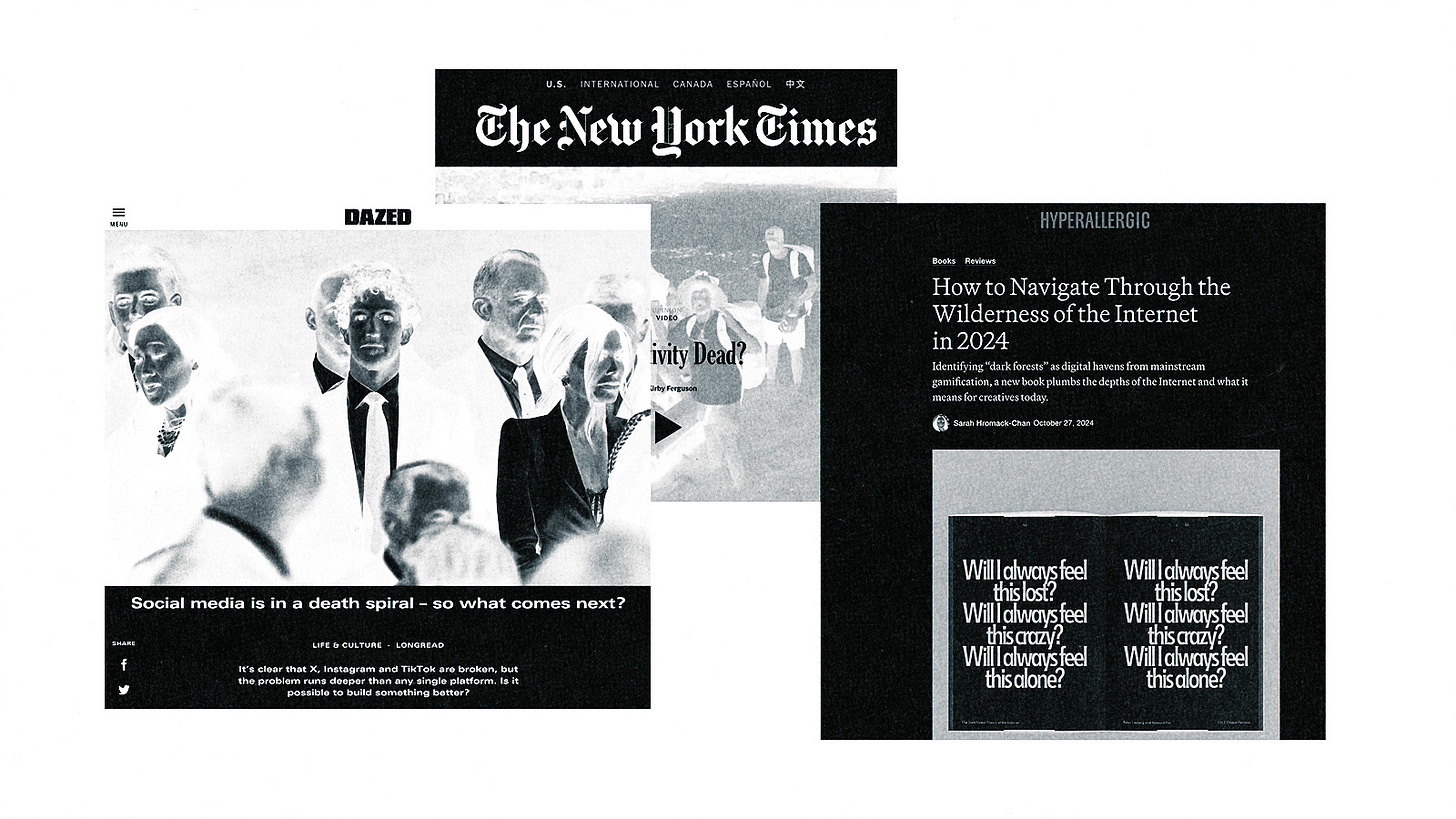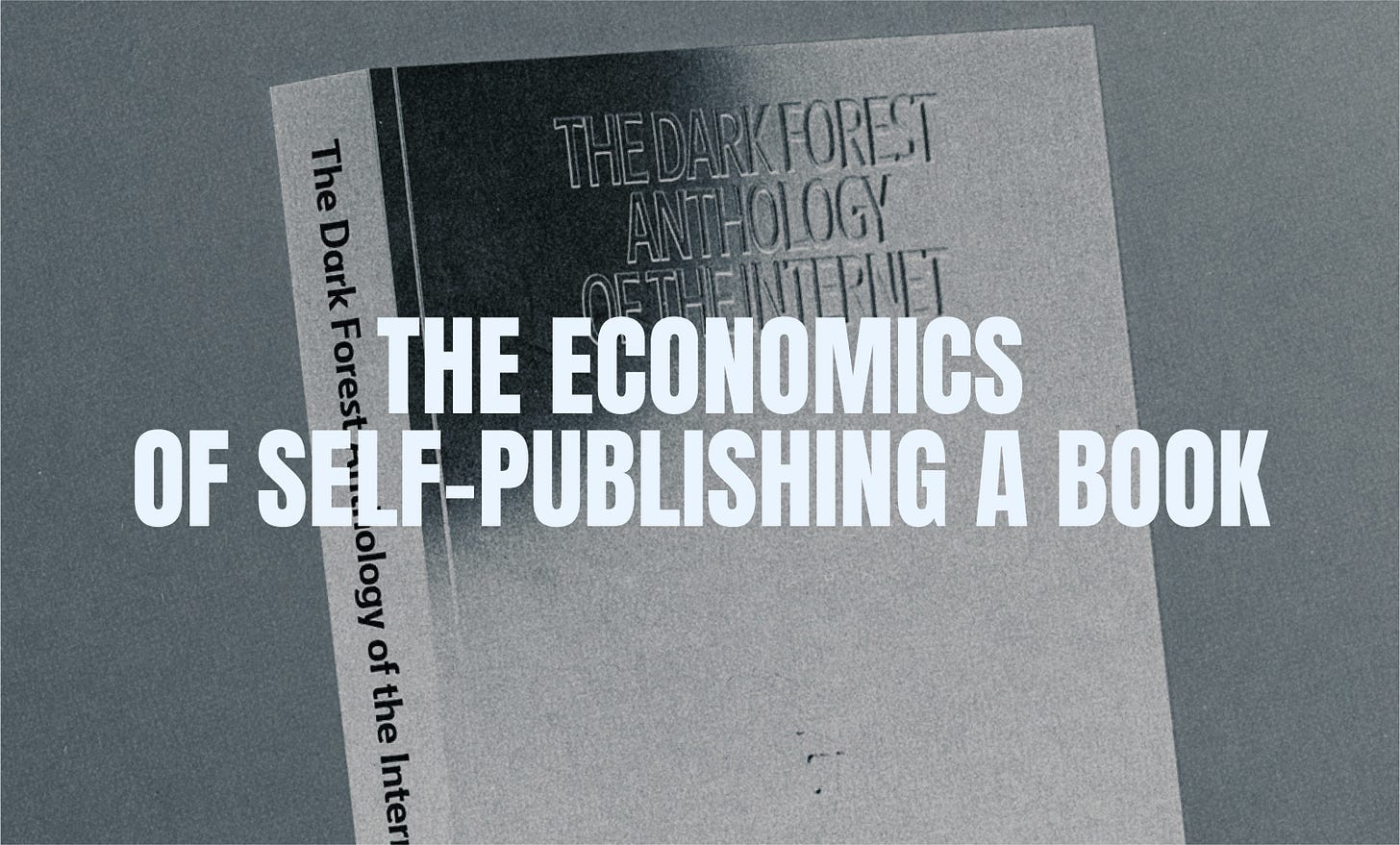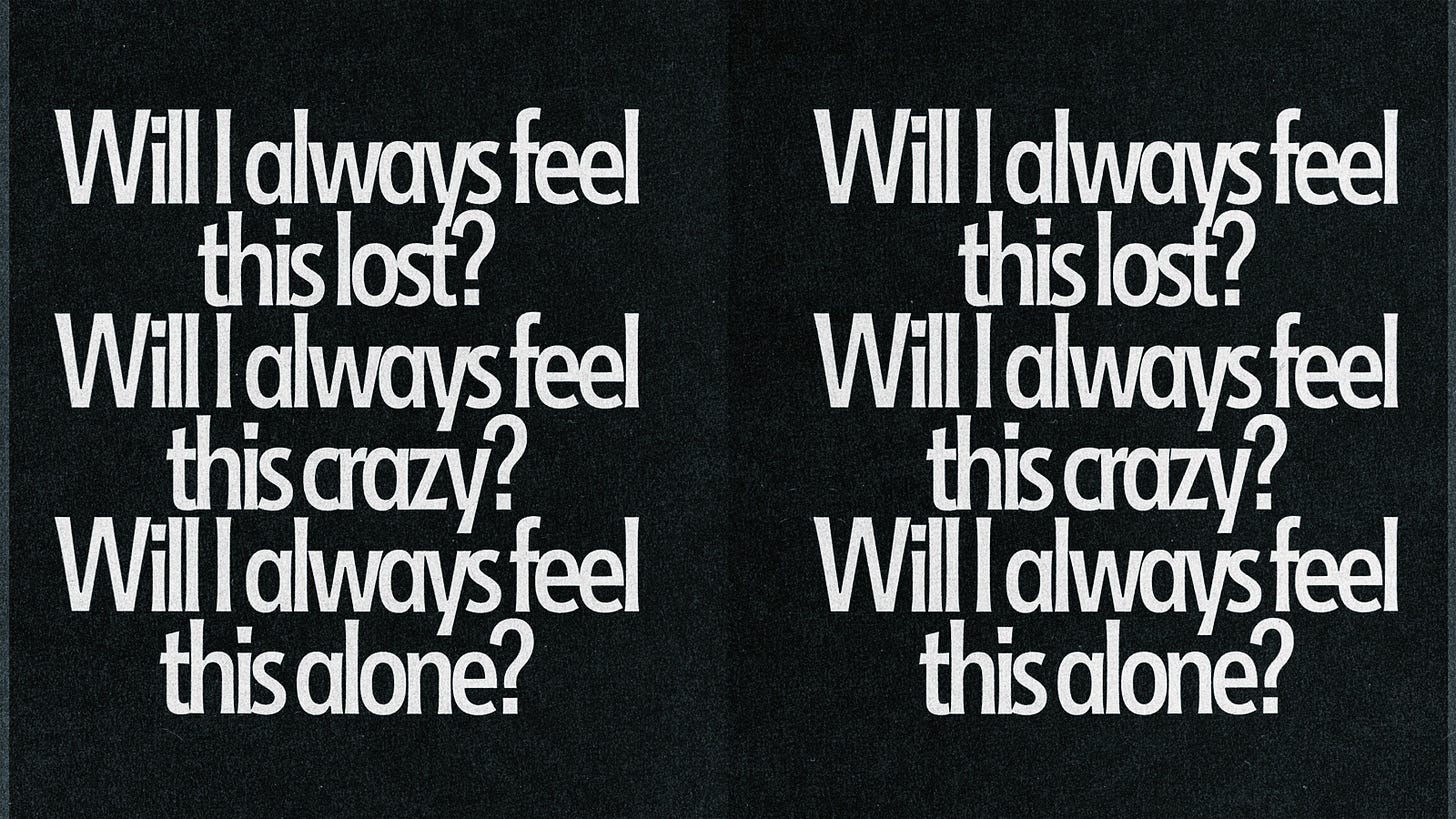The economics of self-publishing a book on Metalabel
A deep dive into the Dark Forest Anthology of the Internet
Last year, a dozen writers (including me) published a book together about how we live online. No publishers, no complex arrangements. But also not quite self-publishing, something better.
The project served as a kind of guinea pig for how far a fluid configuration of collaborators could take a project using only a shared vision, a shared treasury, and automatic splits to distribute money among the group.
Turns out the answer is quite far, and getting farther.
In its first year, The Dark Forest Anthology of the Internet was collected by nearly two thousand people; showed up in Hyperallergic, The New York Times, and the Museum of Modern Art; and earned more than $60,000 in book sales, $30,000 of which were automatically paid out to the authors like a passive royalty stream.
But how did it all work? How much did everything cost? Let’s dig in.
Stats
Title: The Dark Forest Anthology of the Internet
Released: 02/22/24
Collectors: 1,700+
Sales: $66,000 gross volume
Origins
In 2019 I sent a newsletter about why I no longer felt comfortable being myself online called “The Dark Forest Theory of the Internet.” The essay struck a chord and went nerd-viral. Within days other writers were building on the idea.
In 2023, I reached out to the authors of a dozen pieces written in the years since the original essay and suggested we come together to create a living canon of this idea. I shared a link to this proposal and suggested the following economic structure:
I’d personally pay for the designer’s fee; initial sales from the book would pay me back
The costs of printing would be paid for by an advance from Metalabel; those costs would also be recouped
Once costs had been paid for, we would split the money equally
Since the book contained pieces by eight sets of authors, each author set would receive 10% of the book proceeds
The remaining 20% would go to a Dark Forest Collective treasury of money we could spend on new projects (I donated my cut here too)
Based on this structure, I projected each author set to receive ~$1,500 if the initial run of books sold out
After a small bit of back and forth, everyone agreed and the project began to move forward.
Production
To design the book, I connected with Leith Benkhedda, a member of New Models and Do Not Research who also contributed a piece to the Dark Forest Anthology. We agreed on a fee of $3,500 to pay for designing and overseeing the printing. We decided to work with a printer in Berlin near him. (More on that in a moment.)
But how many books to print?
One logic said print as many as possible to keep the costs low. Another logic said don’t tempt fates and overdo it. We decided we’d rather sell out than have too much inventory, and printed 1,000 copies. We made 777 available on Metalabel, set aside 50 for journalists, and sent 150 to independent book and design stores.
Cost breakdown:
Pre-production: $3,500 for designer ($3.50 per copy)
Production costs: $5,500 for printing ($5.50 per copy)
Shipping costs: $3,500 for customs and shipping from printer ($3.50 per copy)
Total cost per book: $12.50
Two things to point out: the pain that came from having to ship the books from the printer internationally to the distributor. This cost as much as the design fee for the book (ouch!). Also note that I did not pay myself anything for the work I did as editor-producer. In most projects this role should be part of the budget.
Economics
We used Metalabel to package the release as a First Edition bundle that included a physical book, PDF download, and invitation to a roundtable. We priced it at $35 plus $10 flat for shipping.
In a private Telegram, the members of the Dark Forest Collective collaborated to share the book to our own audiences that same week in a coordinated way. Within 72 hours of announcing the book, all 777 editions on Metalabel sold out. Yes!
Because all transactions were moving through our Metalabel treasury, the costs were being deducted and the split was being applied as the money came in.
Total sales:
Gross sales: $37,273 (including $7,830 in shipping)
Production costs recoup: $12,227
Shipping costs: $8,800
Metalabel fees: $3,727 (10%)
Stripe fees: $1,509 (4%)
Net: $11,894
Our fixed costs were recouped at 440 books sold. It took almost half the print run to pay for the costs to make and ship the book. Each contributor set received 10% of the net profit, this worked out to nearly $1,200 per author and nearly $4,000 in the collective treasury for future releases.
Second printing
After the book first sold out, I made a mistake and didn’t immediately post a second printing. Instead the book was unavailable for four months while being talked about online. Not a good decision.
In May we finally made another print run, this time printing 1,500 copies, making 1,111 available on Metalabel. Because we didn’t have to pay design costs and we printed a larger quantity, the economics of this edition were much better:
Production costs: $7,355 for printing ($4.90 per copy)
Shipping costs: $3,000 for shipping from printer (including customs) ($1.45 per copy)
Total cost of each book: $6.35
About a thousand of these second printings have been sold, nearly 700 of them through Metalabel. This has totaled an additional $30,000 in sales. With the lower fixed costs, all expenses were recouped at 350 copies sold.
This second edition has netted out to an additional $2,000 per contributor set and another $7,000 to the Dark Forest Treasury so far, with another several hundred copies to go, and the book continuing to sell briskly.
Add both editions and you get through Metalabel:
$66,000 in gross sales
$25,000 in recouped costs
$34,000 automatically split between the authors
$12,000 in funds for new releases and projects
$6,600 in Metalabel fees
$2,600 in Stripe fees
All of these payments flowing automatically through the Metalabel system.
This also means that whenever a collector purchased a copy, their money was being split among all of these different segments of the project: some of their money paid for costs, while most of it was directly split among the contributors to the project at roughly $2 per person.
IRL sales
The book was also carried by some independent bookstores around the world. All told, we’ve sold around 300 copies in physical stores.
Two interesting learnings to note with this. First, with the Metalabel editions, 85% of sales went to us. For the retail copies, 40% of sales, or roughly $10 per copy, goes to us. This is just enough to cover the cost to print the book itself.
We’ve also learned that payment schedules from bookstores and distributors work at a very different pace than on the web. Whereas Metalabel payouts are instant, we’re still waiting for our first payment from physical sales a year out.
Despite these learnings we appreciate the support and ability to be in physical stores.

Lessons
Looking back at the overall experience, what advice would we give?
DO release something with other people. The experience was way more fun and less daunting than doing things on your own. Collaborating makes promoting the work feel less self-promotey.
DO bring people together under a shared experience you’re all trying to address. Don't just bring people together without a connecting story (e.g. “We’re all painters, let’s make a painting show”). A deeper reason makes it matter more.
DO budget costs in detail before getting started. Accurate forecasting is your friend and reduces headaches.
DO offer people bundles of digital, physical, and IRL experiences. The multidimensional drop made it feel more special.
DO plan in group chats. Making conspiracies with friends = highly recommended.
DON’T need the run to sell out to recoup your costs. Too stressful. This will make the experience less enjoyable and more like pure work.
DON’T do it without splits. Managing the money side of this would have been impossible without that tool.
DON’T try to do too many things at once. We appreciated having only one sales channel to focus on versus trying to fulfill orders from a bunch of different places at once.
DON’T let momentum stop if you happen to sell out quickly. Put up a new edition, let newcomers support you.
DON’T print on another continent. Lesson learned.
Next step: from anthology to publisher
The journey of this project is still beginning.
Next week, the Dark Forest Collective will introduce our second book: a new title from the brilliant Nadia Asparahouva that will expand the dark forest universe and introduce a new lens to better understand our world.
With this new title, we will follow the exact same economic model as this project, with a few new twists we’re adding to the mix. Something we’ll share in a future deep dive.
Follow the Dark Forest Collective and stay tuned here.
Releases from the Dark Forest Collective
The Dark Forest Collective has released two titles on Metalabel. Members of the Dark Forest Collective, including Joshua Citarella, members of Trust.Support, and Ruby Justice Thelot, have also published work with Metalabel.
Read more case studies, release strategies, and audience building tips in Studio—our space for all things inspiring sustainable creative practices.
<3
Metalabel






Hey Yancey, thanks for sharing this. It's really useful info, especially as I prepare for Zyla's first Metalabel release. One question: how do you automatically recoup costs before splitting profits between collaborators? I emailed ML about this and was told that it's not possible to do it automatically and I'd have to manually change the splits once we reach the threshold. Has there been an update or is that how you did it?
Hey, I am still waiting for my hardcopy. :/ What can I do? Thanks